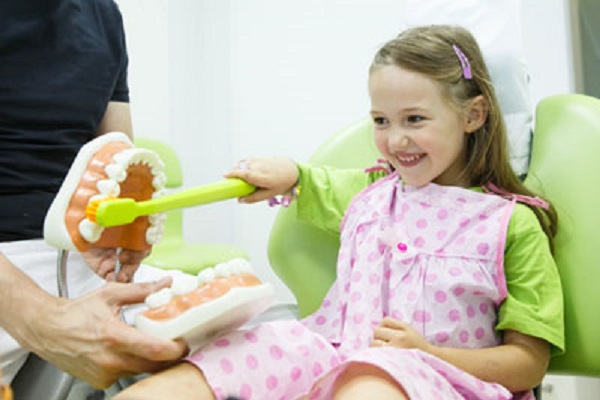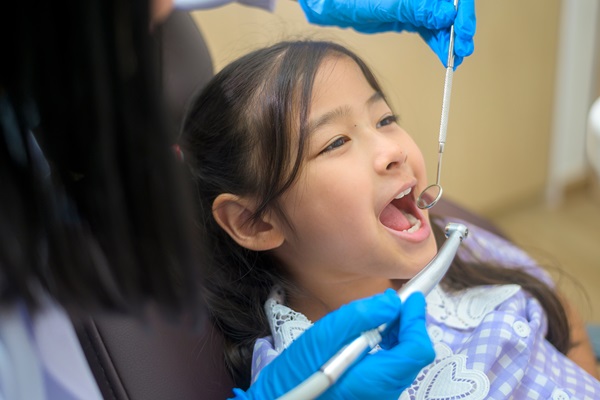At What Age Should Children First See a Pediatric Dentist?

A pediatric dentist has the training to treat and care for the oral health of children. Parents may be wondering at what age a child should first visit the dentist, and the general rule is when the first tooth erupts or by year one. According to the National Institute of Health, more than 40% of children have had at least one cavity by the age of 11. Children’s teeth are susceptible to decay, and it is important to begin good oral hygiene early both professionally and at home.
What to expect at the first visit
The dentist’s office can be an intimidating place for both kids and adults, and one thing a pediatric dentist office does well is help make the child feel comfortable and make the visit fun.
Introduction to the office
During the first visit, the child will be introduced to the front desk staff and may be given a tour of the office to see all the rooms and equipment. The dental hygienist will often ease into the appointment by demonstrating how the chair goes up and down and giving the child a ride. The hygienist may also show the equipment used for cleaning and let the child hold them.
Teeth cleaning
Once the child seems to be comfortable, the hygienist will proceed with the cleaning. Depending on the age of the child and the number of teeth, this may not take very long. The child will also learn how to brush their teeth, and they may also have their teeth flossed.
Exam
After the cleaning, the dentist will come in and make an introduction to the child and parents. They will then conduct an exam of the existing teeth, gums, tongue and cheeks. X-rays may be taken once most of the teeth are in. The dentist may also evaluate how certain habits, such as sucking the thumb or using a pacifier, are impacting the teeth and mouth. At a certain age, fluoride treatments or sealants may be recommended.
Home habits to begin early
Going to the dentist every six months or so is one step in the overall process of having healthy teeth and gums. It is even more important, however, to practice good habits at home from an early age. Even before teeth begin to appear, parents can start to clean a baby’s mouth. Moms or dads can use a soft, damp cloth to wipe the gums after each feeding.
Once the child gets the first tooth, parents should use a brush with soft bristles to brush the tooth and surrounding area. Only water or a non-fluoride toothpaste should be used until the toddler is old enough to spit.
Parents should assist with brushing until the child can hold the brush and coordinate the movements, which is often around age 6 or 7. Flossing can begin at around age 2 or 3, and around the age of 10 the child should be able to floss on their own.
Conclusion
Good oral hygiene begins at an early age, and a pediatric dentist plays an important role in keeping children’s teeth healthy and cavity free. Parents should make the first dental appointment for children at around age 1 or after the first tooth emerges.
Request an appointment here: https://www.grandparkwaypediatricdental.com or call Grand Parkway Pediatric Dental at (832) 579-0960 for an appointment in our Richmond office.
Check out what others are saying about our services on Yelp: Read our Yelp reviews.
Recent Posts
Pediatric dental patients with chipped or broken teeth have more options for tooth repair than in the past, such as composite fillings. These dental fillings can both restore a tooth and prevent the increased chance of gaps in the smile or shifting teeth that usually follows a tooth extraction. They can also provide a natural-looking…
A pediatric root canal can help preserve a child's oral health and prevent further complications when a tooth becomes damaged or infected. A dentist will determine if treatment is necessary based on symptoms and an examination. Understanding the signs of infection and the treatment process can help parents make the best decision for their child's…
Created with quartz or glass and using a resin medium, composite fillings are quickly becoming the go-to for many pediatric dentists. The fillings restore functionality to broken teeth by allowing the patient to bite or chew without pain. In addition, because the fillings look like natural teeth, they may help with self-esteem in relation to…
Dental caries, commonly known as tooth decay or cavities, are a prevalent dental problem among children. Composite fillings are one great solution to this often painful and sensitive issue. Composite fillings work to stop tooth decay in its tracks while still allowing filling recipients to maintain a more natural-looking smile.Composite fillings, composite resin fillings, or…


